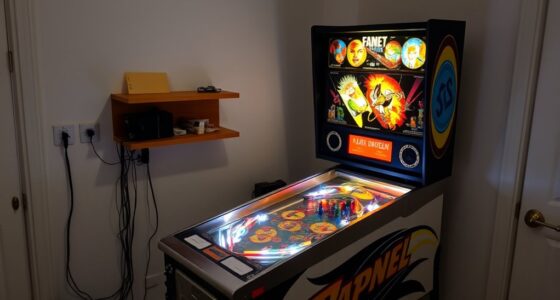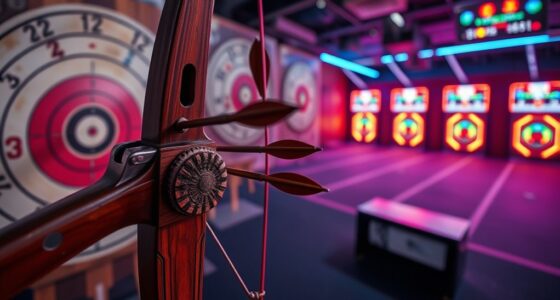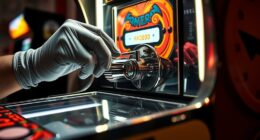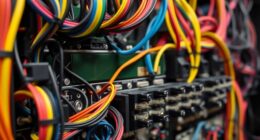Today, pinball machines are built through precise design and assembly processes that combine craftsmanship with modern technology. You start with detailed digital models, then prepare the cabinet and frame, often using automated machinery for accuracy. Electronic components like circuit boards, sensors, and lights are integrated and tested. The playfield and mechanical parts are assembled, calibrated, and tested for smooth operation. Finally, the machines are wired, checked for quality, and carefully packaged—learn more to see how each step guarantees a durable and engaging game.
Key Takeaways
- Modern pinball machines start with detailed digital designs and schematics to ensure precise component fitting.
- Assembly lines, either manual or automated, prepare cabinet frames and integrate electronic components securely.
- Electronic parts like circuit boards, sensors, lights, and sound systems are sourced, mounted, and tested for durability.
- The playfield and mechanical parts are crafted from high-quality materials, then assembled and calibrated for smooth gameplay.
- Final assembly includes wiring, testing, quality checks, and careful packaging before shipping to ensure reliability and safety.

Manufacturing pinball machines involves a complex process that combines precise engineering, craftsmanship, and modern technology. You start by designing detailed schematics and digital models, guaranteeing every component fits perfectly and functions reliably. Once the design is finalized, production shifts to the assembly line, where each step is carefully orchestrated to maximize efficiency and quality. Central to this process are electronic components, which form the brain of the machine. These include circuit boards, microcontrollers, sensors, lights, and sound systems that bring the game to life. You’ll find that sourcing high-quality electronic components is essential because they determine the machine’s durability and performance over time.
Manufacturing pinball machines combines precise engineering, craftsmanship, and advanced technology to create durable, high-quality entertainment systems.
On the assembly line, the process begins with preparing the cabinet and frame. Skilled workers or automated machinery assemble the wooden or metal shell, guaranteeing it’s sturdy enough to withstand years of gameplay. Afterward, the electronic components are integrated. Circuit boards are mounted, wired, and tested to guarantee all connections are secure and functioning correctly. This step requires precision, as even a tiny error can cause malfunctioning later. During this phase, technicians verify the operation of lights, switches, and sound modules before sealing the internal compartments. The use of modern technology also helps streamline assembly line processes, reducing production time and minimizing errors.
Next, the playfield comes into play. It’s crafted from high-quality wood or composite materials, meticulously painted and coated. The placement of electronic elements, such as sensors and lighting fixtures, is carefully planned and executed. The playfield features various mechanical parts—flippers, bumpers, targets—that are assembled separately and then installed onto the main structure. These mechanical parts often work in tandem with electronic sensors, so calibration during assembly is essential for smooth operation.
The installation of the control panel and backbox follows. This section houses the main electronic control systems, including the scoreboard, coin mechanism, and user interface. Wiring the control panel involves connecting buttons, switches, and displays to the central circuit boards. Once everything is wired and tested, the entire machine undergoes a series of quality checks. These tests include verifying gameplay mechanics, electronic responsiveness, and safety features.
Throughout the manufacturing process, modern technology plays an indispensable role in streamlining assembly line processes. Automation handles repetitive tasks like wiring and component placement, reducing errors and speeding up production. Meanwhile, technicians focus on quality control, guaranteeing each pinball machine meets strict standards for safety, durability, and fun. When completed, these machines are carefully packaged and prepared for shipping, ready to entertain players with their intricate combination of electronic and mechanical systems.
Frequently Asked Questions
How Long Does It Typically Take to Manufacture a Pinball Machine?
It typically takes about 8 to 12 weeks for you to see a finished pinball machine, depending on the production timeline and complexity. The manufacturing duration involves designing, assembling, and testing each unit to guarantee quality. As you follow the process, you’ll notice that attention to detail and customization can extend or shorten this timeline. Overall, patience pays off for a high-quality, fully functional pinball machine ready for play.
What Materials Are Most Commonly Used in Modern Pinball Construction?
You’ll find that the most common materials used in modern pinball construction include high-quality MDF or plywood for the cabinet, stainless steel or aluminum for the metal parts, and tempered glass for the playfield cover. You also see plastics and rubber for bumpers and targets. Construction techniques focus on precision assembly, durable joints, and reinforced structural elements to guarantee longevity and consistent gameplay. These choices balance durability, aesthetics, and cost-efficiency.
Are There Eco-Friendly or Sustainable Practices in Current Pinball Manufacturing?
You might think pinball manufacturers are all about eco-friendly practices, but surprisingly, they’re making strides with recycling initiatives and sustainable sourcing. While it’s ironic that such loud, flashy machines could be green, some companies are genuinely reducing waste and sourcing responsibly. So, yes, there’s a growing movement toward sustainability, proving even nostalgic gaming can go green — if you look closely enough.
How Has Automation Impacted the Quality Control Process?
Automation has greatly improved your quality control process by increasing efficiency and consistency. You now rely on advanced quality assurance techniques, such as automated inspections and sensors, which quickly detect defects and ensure each pinball machine meets high standards. This reduces human error, speeds up production, and guarantees a more reliable product. Overall, automation enhances your ability to deliver top-quality pinball machines while streamlining operations and maintaining rigorous quality standards.
What Customization Options Are Available During Manufacturing?
During manufacturing, you can choose from various customization options like custom design elements, which let you personalize artwork and themes. You also have the option to add LED lighting, enhancing visual effects and gameplay ambiance. These choices allow you to create a unique pinball machine tailored to your preferences, making your gaming experience more exciting and personalized. Manufacturers work closely with you to incorporate these features seamlessly into the production process.
Conclusion
So, as you see, manufacturing pinball machines today combines craftsmanship with technology, precision with creativity, and tradition with innovation. You get to experience the intricate assembly, the detailed design, and the cutting-edge components coming together in perfect harmony. It’s a process that celebrates the artistry, the engineering, and the passion behind every machine. And as you play, remember, it’s this blend that keeps the game alive, exciting, and endlessly enthralling for everyone.









